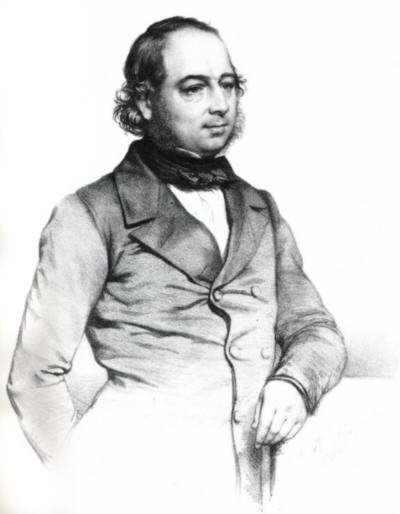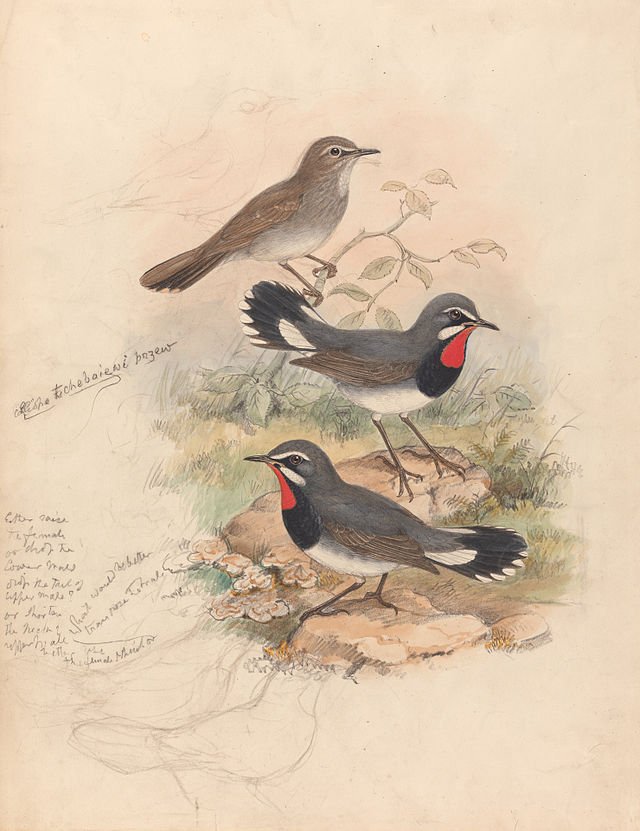 John GouldA few weeks ago, while shuffling past the oversize book shelves at the Rutland Free Library, a tome, fronted with a painting of a sharp-eyed merlin, alighting on its nest, with her desperately gaping young, caught the corner of my eye. Boldly titled John Gould’s Birds, my curiosity was now piqued, and I had to take a closer look. After flipping through just a few pages, I knew that, despite being already burdened down by clunky boots, a down coat and several books for winter reading, this had to be added to my pack.
John GouldA few weeks ago, while shuffling past the oversize book shelves at the Rutland Free Library, a tome, fronted with a painting of a sharp-eyed merlin, alighting on its nest, with her desperately gaping young, caught the corner of my eye. Boldly titled John Gould’s Birds, my curiosity was now piqued, and I had to take a closer look. After flipping through just a few pages, I knew that, despite being already burdened down by clunky boots, a down coat and several books for winter reading, this had to be added to my pack.
John Gould is known for his publications on the birds and animals of three continents, monographs on toucans, trogons and hummingbirds, illustrations for two ships’ voyages, and about 300 scientific articles.
He was born on September 14, 1804, in Lyme Regis, Dorset, England, a town noted for its healthy clime and restorative bathing opportunities, certainly a snug “nest” for someone with a bent for nature. A childhood family move to Surrey, an area rich in wildlife, provided a variety of meadows, woodlands, ponds and rivers for exploration. He collected nests and shot specimens. As I’ve learned from my previous reading (and related in my book reviews), this was considered at the time, not mischievous antics, but wholesome, and was common in the U.S. as well. The introductory chapter included a side comment that Great Britain passed its “Wild Birds Protection Act” in 1880. I couldn’t help wonder, why, despite our pompous declaration of rights, liberty and democracy, the Brits were decades ahead of us in taking a stand against slavery AND against mindless destruction of birds.
Gould’s father was a gardener, eventually attaining a position at the grounds of Windsor Castle, where the young Gould was placed under a Mr. Archer for further horticultural training. However, John found his interest turned toward taxidermy. In 1825, he set up business as a taxidermist in London where he became renowned for his skills. In 1827, he was appointed “Curator and Preserver” to the Zoological society of London. He preserved a great number of specimens for their museum’s constantly growing collection.
In 1830, Gould somehow acquired a collection of Himalayan bird skins which he stuffed and mounted. Perceiving their artistic qualities he visualized how well they would look in an illustrated book. The previous year Gould had married Elizabeth Coxell, an accomplished artist with talent that surpassed her pedagogical drawing duties as a governess. Thus, Elizabeth was engaged to draw the Himalayan birds.
Gould himself was not primarily responsible for the fine art work of the bird illustrations. The plates were based on rough drawings Gould made of the mounted model. These were pencil or charcoal sketches indicating the position of the birds on the page, plants to be used, and perhaps a few dabs of suggested color. Elizabeth (and later other artists) painstakingly produced the detailed lithographic plates and drawings. Another group of watercolorists did the final painting of the prints.
 Gould found 298 subscribers for his Himalayan bird book, mainly gentlemen, earls, lords, dukes, institutions and natural historians. He continually obtained specimens through his Zoological Society contacts. Next came Birds of Great Britain, Birds of Europe and Birds of Australia, for which Elizabeth journeyed with him to the southern continent. However, because of her untimely death at age 37, Gould was obliged to find other illustrators to complete the Australian and future works. Edward Lear and Henry Richter were notable artists who illustrated over 1000 plates.
Gould found 298 subscribers for his Himalayan bird book, mainly gentlemen, earls, lords, dukes, institutions and natural historians. He continually obtained specimens through his Zoological Society contacts. Next came Birds of Great Britain, Birds of Europe and Birds of Australia, for which Elizabeth journeyed with him to the southern continent. However, because of her untimely death at age 37, Gould was obliged to find other illustrators to complete the Australian and future works. Edward Lear and Henry Richter were notable artists who illustrated over 1000 plates.
One naturally is inclined to compare Gould and Audubon. Not only had Gould purchased some Audubon prints in 1827, but the two men apparently knew each other. Audubon borrowed skins from Gould and acquired a (live) dog from him.
Personality-wise, they seem to have been near opposites. The text notes that Gould’s “business methods remained brusque and direct, and he never seemed to have acquired the finesse of a gentleman.” On the other hand, Audubon was a social charmer when seeking subscribers in London. With his “shoulder-length chestnut ringlets and fringed buckskin jacket” he became the archetypical beloved “American Woodsman.” A significant difference was that Audubon had received training as an artist in Paris at the atelier of the great French master Jacques-Louis David.
Their techniques and styles were different. Gould utilized taxidermists’ specimens situated in stereotypical positions. His model’s feathers were often faded. Audubon set up recently killed birds in positions secured by wires. His compositions could become quite complex and appear staged, to the point of being contorted and almost “frenzied” such that some scientists questions their accuracy. Audubon appeals to the spectacular and striking, Gould to the formal and lyrical. “There are, for example, Audubon’s pintail ducks whose necks crane upward eager to catch a moth, whereas Gould’s ducks are quietly waddling toward the water. Audubon’s great white heron strides forward with a fish in its bill; Gould’s pair of herons is perched side by side in a tree. Audubon’s great black gull dies bleeding its wing shattered by a storm, whereas Gould’s gull glides peacefully through the water.”
Another clearly evident difference is that virtually all of Gould’s birds are done in vignette format, while Audubon often uses the entire sheet for his painting. Gould’s colors tend toward earth tones – ochre, russets, burn orange, umber, olive green, stormy blues, while Audubon’s encompass a wider spectrum and are more vivid. It seemed to be that Gould’s illustrators’ employment of more subtle, less saturated palette enabled them to achieve finer detail. In this respect, the accompanying wildflowers and plants are as exquisitely rendered as the birds, and they could serve as a fine reference for botanists except for the point that, oddly, they are not identified. If they deserve such study and care in their depiction, one might think a comment would be made as to the possible necessity of the plant in the bird’s chosen habitat. For example, goldfinches flittering about teasel – do they extract tiny seeds from the pods?
Check this one out at the library. Oversize books are upstairs, main room, far west stack. Often, many are set up in display fashion. And, yes, any oversize book can be checked out and taken home. Just bring a big pack!